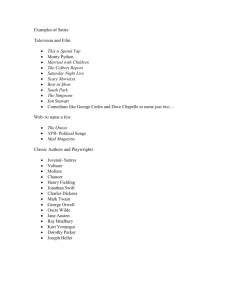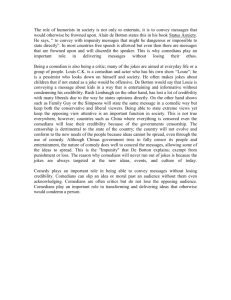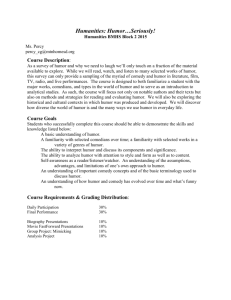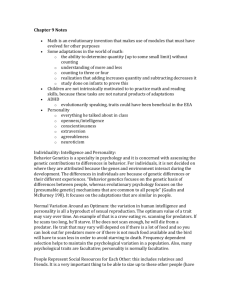Results
advertisement
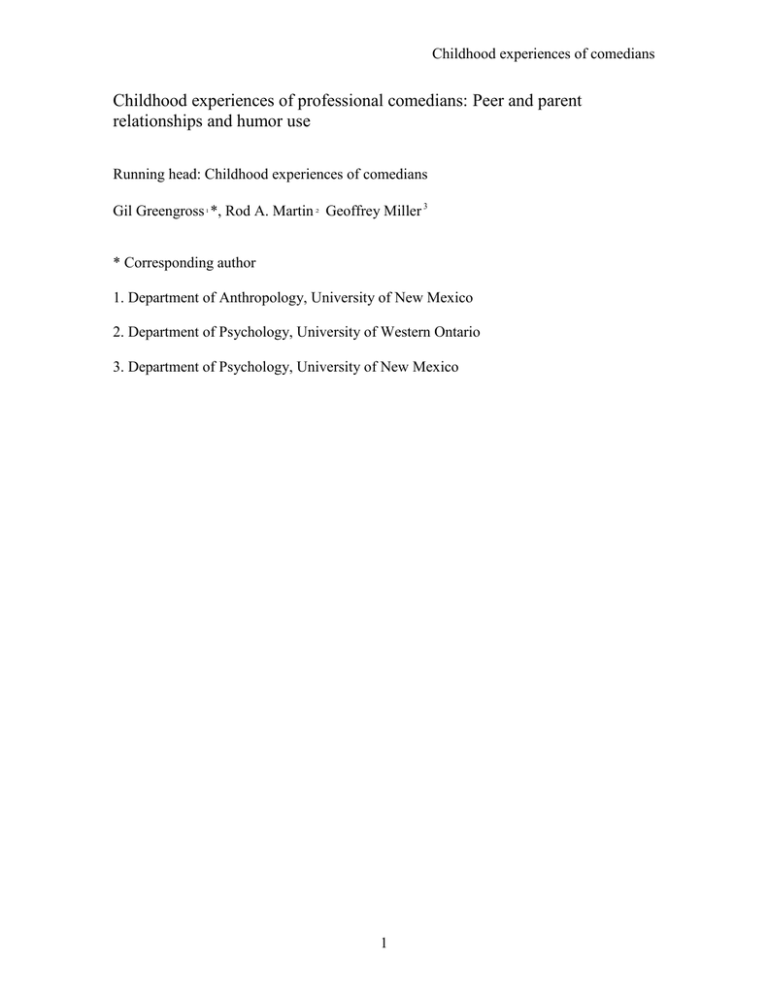
Childhood experiences of comedians Childhood experiences of professional comedians: Peer and parent relationships and humor use Running head: Childhood experiences of comedians Gil Greengross *, Rod A. Martin Geoffrey Miller 3 1 2 * Corresponding author 1. Department of Anthropology, University of New Mexico 2. Department of Psychology, University of Western Ontario 3. Department of Psychology, University of New Mexico 1 Childhood experiences of comedians Abstract This study examines a commonly held belief, left over from psychoanalytic theories of humor as a coping mechanism, that relationships with parents strongly influence comedians’ temperaments and career choices. Thirty one professional stand-up comedians and 400 students completed the Parental Bonding Instrument (PBI), which concerns recollected parental care and protectiveness, and a new self-report questionnaire that measures popularity and humor use among peers during adolescence. Results show that comedians’ parents did not differ from students’ parents in care or protectiveness, and comedians did not differ from students in adolescent popularity, but comedians did use more humor among adolescent peers (were more likely to be class clowns, make fun of others, laugh at themselves, and be the butt of jokes). The results suggest that stand-up comedians do not differ much from ordinary college students in their parental or adolescence peer relationships. Key words: humor, comedians, stand-up comedy, parental bonding, development 2 Childhood experiences of comedians Introduction There is a widely held belief that professional humorists, such as comedians, are sad or depressed (Janus, 1975; Janus, Bess, & Janus, 1978). The reasons for this alleged glumness vary, but many think that its roots have to do with an unhappy childhood or troubled relationships with parents. According to this view, comedians’ performances on stage serve as a coping mechanism, enabling them to escape from their daily troubles (Janus, 1975; Janus, et al., 1978). Early research showed that comedians are likely to come from a low socioeconomic stratum (Fisher & Fisher, 1981; Janus, 1975; Janus, et al., 1978). Approximately 80-85% of comedians in two separate studies, one with 55 nationally known comedians (51 males), and another with 14 female comedians, came from low socioeconomic homes (Janus, 1975; Janus, et al., 1978). The harsh conditions at home may explain why comedians went on to pursue their career. In a study of 43 comedians (35 males, 8 females, 15 of them clowns), Fisher and Fisher (1981) found that, compared to a control group of professional actors and other entertainers, comedians were more preoccupied with themes of good and evil in their responses to interviews and projective tests. The authors of the study attributed this finding to the fact that the parents of future comedians placed much responsibility on their shoulders early in childhood, requiring them to take on an adult role at an early age. They had to take care not only of themselves, but also of their siblings, and many of them worked as teens to support their parents. According to Fisher and Fisher, these untimely demands and heavy expectations put pressure on the comedians while growing up and drove them to seek approval, hence trying to be as “good” as their parents wanted them to 3 Childhood experiences of comedians be. Falling short of parents’ expectations produced different responses from their parents. Fathers usually were disappointed that the comedians did not reach their high expectations; thus the comedians felt they were “bad” from their fathers’ perspective. Many of the comedians’ mothers expected them to fail, just waiting for this to happen. Fisher and Fisher proposed that one of the main reasons why these comedians pursued a comic career was to prove that they are not bad, and they are doing “good.” Compared to the actors, Fisher and Fisher (1981) observed that comedians typically described their fathers in much more positive terms, such as “good,” “nice,” and “respected.” On the other hand, they describe their mothers as being rule enforcers, disciplinarians, punishers, and aggressive critics. Many comedians acknowledged that they were spanked, hit, and punished when they violated their mothers’ rules. In reaction to pictures depicting mother figures in the Thematic Apperception Test (TAT), comedians were less likely than the actors to describe these women as having maternal qualities or to refer to them specifically as mothers. In contrast, they did ascribe paternal identity to father-like figures in the same task. Contrary to Fisher and Fisher, Janus (1975) found that male comedians overwhelmingly reported being closer to their mothers, indicating that mothers played a more active role in their lives than did their fathers. Mothers were seen as more accepting figures than fathers, spending more time with them, encouraging them to pursue a comic career, and better understanding their need to become a comedian. Fathers were often absent during their childhood, or generally uninterested in their career and even discouraging them from pursuing it. Fathers also failed in many cases to 4 Childhood experiences of comedians support their families, forcing the mothers to go to work. The fathers were also resentful of the close bond between the mothers and the aspiring comedians. In a subsequent study with female comedians, Janus (1978) found an opposite trend. Female comedians felt closer to their fathers, and several of them reported being raised without a mother, who died at an early age. Fathers were role models for the comediennes, and they grew up admiring them. Similar to the male comedians, fathers were generally described as poor providers, and the comediennes felt they needed to support and encourage them. Their mothers were described as unsuccessful, struggling, and unhappy, and most of them lived the traditional role of a housewife. Relationships with their siblings were good, overall, and interestingly, 55% of comediennes were the youngest child in the family. With regard to academic performance and relationships with peers, Fisher and Fisher (1981) found that comedians struggled with school and were below average students. Comedians tended to be funny early in life and in school, describing themselves as being the class clowns, mocking teachers and friends and making practical jokes. In Janus’ (1975) study, comedians reported having good relationships with peers and siblings, though they often felt misunderstood, being picked on and disparaged. Janus also reported that comedians’ childhood experiences were marked by isolation, suffering, and deprivation feelings. In his view, being funny serves as a defense mechanism against panic and anxiety. Only when on stage could they enjoy a short period of relief from their fears. Janus concluded that comedians were sad, depressed, suspicious, and angry (Janus, 1975). These findings are consistent with another study of 96 class clowns, most of them male, from a middle school (Damico & Purkey, 1978). 5 Childhood experiences of comedians The study found that the class clowns were more assertive, disobedient, attentionseeking, cheerful and showed leadership, but were worse students, compared to their classmates, as evaluated by their teachers. The class clowns in this study asserted that they were not well understood by their parents and had negative attitudes toward teachers and principals. All these experiences in school, combined with their relationship with their parents, suggest that comedians become what they are in an effort to seek control, get approval from friends and family, and prove that they are good and worthy. Comedians’ performance on stage, in this view, comes as a defense or compensation mechanism for their melancholy lives, whereby they attempt to channel feelings of anger and anxiety into their comedy act and seek the love of the audiences (Fisher & Fisher, 1981). Using humor as a coping mechanism is not unique to professional comedians; humor has long been viewed as a healthy defense mechanism or coping strategy for adults as well as children (Dixon, 1980; Freud, 1928; Vaillant, 2000). The Janus and Fisher and Fisher studies rely heavily on a psychoanalytical approach that is largely based on projective tests with low reliability and validity and subjective interpretation (e.g. Wood, Nezworski, Garb, & Lilienfeld, 2001; Wood, Nezworski, Lilienfeld, & Garb, 2003). This makes it hard to come to robust conclusions about comedians’ childhood and early experiences, and may account for the contradictory results in these studies, despite using similar samples. Moreover, the comedy scene has changed dramatically since the time of these studies, and comedians today may be quite different from the ones studied in the past. Today there are many more professional comedians and aspiring comics, and many more comedy clubs that host several 6 Childhood experiences of comedians performances each week. Thus, a career in comedy may be less unusual and peripheral than it once was. A further potential limitation of the Fisher and Fisher (1981) study is the use of actors and other stage entertainers as a comparison group. These comparisons might not be adequate to assess whether comedians indeed had unique childhoods and distinct relationships with parents, since both groups had unique vocations that do not represent most of the population. The present study attempts to answer two questions: 1) Do professional comedians have unique relationships with parents compared to others? and 2) What were their experiences in school and the nature of the relationships they had with peers? The results could shed light on what factors influence the pursuit of comedy as a career choice. Method Participants Thirty-one professional comedians (28 men, 3 women) were recruited through a local comedy club in Albuquerque, NM. The comedians had an average age of 38.9 years (SD = 8.6, range 27-58). Comedians had an average of 15.3 years of education (SD = 2.6). Twenty two participants (71%) self-identified as White, 5 (16%) as African American and 4 (13%) as Hispanic. Four hundred undergraduates (200 males, 200 females) enrolled in psychology courses at the University of New Mexico participated in the study and received partial 7 Childhood experiences of comedians course credit for participation. The average age of the students was 20.6 years (SD = 4.7, range 18-57). Participants had an average of 13.4 years of education (SD = 1.3). Two hundred thirty-one participants (58%) self-identified as White, 117 (29%) as Hispanic, 19 (5%) as Asian, 14 (3.5%) as American Indian, 12 (3%) as African American, and 5 (1.5%) as other. Relationship with parents To assess relationships with parents, participants completed the Parental Bonding Instrument (PBI) (Parker, Tupling, & Brown, 1979). The PBI is a 25-item questionnaire that measures parental styles as perceived by the participant in retrospect. The participants were instructed to answer how much a described behavior or attitude reflected their parent in the first 16 years of their lives. The answers range from 1 - “very like” to 4 - “very unlike.” Twelve items measure the parent’s “care” (e.g. “Was affectionate to me”), and 13 measure “overprotection” (e.g. “Tried to control everything I did”). For each parental style, the scores for those items are summed. The instrument is completed for both mothers and fathers separately. The PBI has good reliability and validity (Lizardi & Klein, 2005; Wilhelm, Niven, Parker, & Hadzi-Pavlovic, 2005; Wilhelm & Parker, 1990). Cronbach’s α’s for the current study revealed high internal consistencies: mother’s care = .93, father’s care = .93, mother’s overprotection = .86, and father’s overprotection = .86. Relationship with peers To measure relationships with peers, participants completed the Peer Relationships and Humor Questionnaire, which was developed specifically for this study 8 Childhood experiences of comedians and consists of questions about social life and humor used in school. There were eight retrospective questions, repeated for each of three grades (6th, 9th, and 12th). Participants had to compare themselves to others on a scale from 1 to 7, where 1 means they were below average on this question and 7 means they were above average. Scores were averaged for each question across the three time periods. Cronbach’s α’s for the all eight constructed averages were high and ranged from .66 to .88. The first four questions measure popularity, while the last four questions assess social uses of humor. The questions were: 1. Compared to others, how many same sex friends did you have during the following periods of time? 2. Compared to others, how many opposite sex friends did you have during the following periods of time? 3. Compared to others, how often did others seek you out for social activities during the following periods of time? 4. Compared to others, how popular were you during the following periods of time? 5. Compared to others, how often did you make fun of yourself during the following periods of time? 6. Compared to others, how much were you considered as the class clown during the following periods of time? 7. Compared to others, how much were you the butt of the jokes of other people during the following periods of time? 8. Compared to others, how much did you make fun of other people during the following periods of time? 9 Childhood experiences of comedians Results An index for each question on the Peer Relationships and Humor Questionnaire was calculated, based on the average score for each question across the three time periods. Table 1 displays the correlations among all four social uses of humor for both comedians and students. For comedians there were two significant positive correlations, between being the butt of the jokes and made fun of oneself (.42), and between making fun of others and being the class clown (.36). All correlations among students were positive and significant. Insert Table 1 about here Since most of the comedians in this study were men, a separate analysis for male only was conducted. In this analysis, only the correlation between being the butt of the jokes and made fun of oneself was significant for comedians (r = .39, p < .05). For students, all correlations were again positive and significant, albeit slightly lower compared to the entire sample. The correlations between the four humor behaviors with PBI and peer relationships are displayed in Tables 2 (for comedians) and 3 (for students). Overall, the results indicate that for comedians, both being the class clown and making fun of others positively correlate with number of friends of both sexes and popularity. There were no significant correlations between the humor questions and the PBI. Very similar results were obtained using only the men’s data. 10 Childhood experiences of comedians Insert Table 2 about here Insert Table 3 about here Table 4 shows the means and standard deviations for each scale for comedians and students. Using t-test, we compared the differences between comedians and students on each of the four scales of the PBI. None of the differences were statistically significant. Insert Table 4 about here Again, since most of the comedians in the study were men, a separate analysis that included only male participants was conducted. The results were similar to the entire sample and no group differences were found. Next, we compared the two groups on each of the items in the Peer Relationships and Humor Questionnaire. Results are shown in Table 5, along with Cohen’s d (Cohen, 1988). There were no significant differences in any of the four scales that measure social relationships with peers. In contrast, comedians scored significantly higher on each of the questions that pertain to humor activities with peers. Insert Table 5 about here 11 Childhood experiences of comedians Again, a comparison between male comedians and male students was conducted on the same scales. Results were similar to those in Table 5. There were non-significant differences on the first four scales. For the other four scales, male comedians scored higher on each dimension: made fun of oneself, [t (226) = 2.86, p < .01, d = 0.51]; class clown, [t (226) = 3.07, p < .01, d = 0.65]; butt of the joke, [t (225) = 1.19, n.s., d = 0.24]; made fun of others, [t (226) = 2.85, p < 0.01., d = 0.53]. The students’ sample reveals two significant sex differences. Men were more likely to report being the class clown [t (396) = 6.55, p < .001, d = 0.66], and more likely to be the butt of the joke [t (395) = 3.84, p < .001, d = 0.39]. There was a slight tendency for men to be more likely to make fun of others, [t (398) = 1.75, p < .1, d = 0.18]. Discussion The purpose of this study was to examine whether professional comedians differ from others in their relationships with parents and peers during childhood and adolescence. Overall, there were no differences in the way comedians describe how their parents treated them, compared to the students’ descriptions. Major differences emerged in respect to the way they report having used humor with their peers during adolescence. Results also showed that relationships with parents are largely independent of relationships with peers. The results suggest that the interactions of comedians-to-be with people within the same age group are important to their development as comedians. This is consistent with the fact that humor is a social phenomenon. There is abundant evidence showing that people engage in humor and laugh more frequently when they are with other people 12 Childhood experiences of comedians than alone, and that humor plays an important role in peer bonding and attracting mates (Greengross & Miller, 2008; Lundy, Tan, & Cunningham, 1998; Martin & Kuiper, 1999; Provine, 2000). Making fun of others and being the class clown allow individuals to connect with others. Granted, not all class clowns become professional comedians, but those who do might observe how others enjoy their humor, and decide to advance their skills toward the pursuit of a comic career. Comedians’ use of different types of humor growing up might have built their confidence, provided important experiences and contributed to the development of their personality. Comedians in this study also reported having a tendency to make fun of themselves and being the butt of the joke. This tendency to use self-directed humor was not related to any social benefits (popularity or number of friends) for comedians, whereas among students it was moderately linked to popularity and number of same and opposite sex friends. To attempt to explain this difference between the comedians and students, it is important to note that people use self-deprecating humor in a variety of ways, some beneficial and some not. For some people, self-deprecating humor arises from a negative self-image and involves excessively self-disparaging humorous comments. For others, it arises from positive self-esteem, and involves an ability to make light of one’s own weaknesses and failures, in a self-accepting way (Greengross & Miller, 2008; Martin, Puhlik-Doris, Larsen, Gray, & Weir, 2003). The findings of Fisher and Fisher (1981) suggest that self-disparaging humor of comedians may be more of the negative kind. They found that comedians, compared to actors and other entertainers, were more likely to perceive themselves as unworthy, to make negative remarks about themselves, and to view themselves as small. These findings suggest feelings of 13 Childhood experiences of comedians uncertainty or lack of confidence among comedians, resulting in excessively selfdisparaging humor that others find unfunny and hence lowers the perceived popularity of the joke-teller. Corroborating this is the strong relationship between self-deprecating humor and being the butt of others’ jokes (for both comedians and students), suggesting that comedians indeed used a negative style of humor. On the other hand, students who use a keen self-deprecating humor that makes others laugh, enjoy higher esteem among friends, as shown by the significant positive correlation between self-directed humor and popularity in this group, whereas this correlation was non-significant among comedians. Consistent with previous studies, being the class clown was related to being popular in general, and was also associated with having more friends from both sexes (Warnars-Kleverlaan, Oppenheimer, & Sherman, 1996). These relationships are stronger for comedians than for students, suggesting that comedians might use humor as a tool for social approval. Also consistent with previous studies, there were overwhelmingly more male than female comedians in this study (Fisher & Fisher, 1981; Janus, 1975). Despite changes in the comedy industry over the last few decades, the percentage of female comedians has remained at about 10-15%. It is not yet clear why there are relatively few female comedians. However, it is noteworthy that more men report being the class clowns, something that is consistent with previous studies (Damico & Purkey, 1978; Fisher & Fisher, 1981; Janus, 1975). Thus, males’ greater tendency to use humor to make others laugh seems to begin in childhood and adolescence. Although this study uses a relatively small sample of professional stand-up comedians, it is the largest quantitative study of such comedians done since the 14 Childhood experiences of comedians pioneering work of Janus (1975) and Fisher & Fisher (1981). The results give no support to the common view that comedians had especially difficult relationships with their parents (as indexed by the care and over-protectiveness scales of the PBI) or their adolescent peers. The main difference between professional comedians and ordinary college students is that the comedians recalled being funnier during adolescence. While it is true that sense of humor is heritable to some degree (Manke, 1998; Vernon, Martin, Schermer, Cherkas, & Spector, 2008), humor is dynamic and changes throughout one’s life. It is not known how comedians’ humor is similar to their parents, but it seems that they develop their sense of humor in response to other people and to their own experiences and feelings (Fisher & Fisher, 1981; Janus, 1975). One limitation to this study is that the comedians were older than the students, and thus might be less accurate in their recall of childhood experiences. However, the fact that comedians expressed both positive and negative attributes about themselves growing up may indicate that the bias is relatively small. It is also possible that while parents do not greatly influence adolescence, they do influence the development of children’s humor in early years (McGhee & Chapman, 1980). Another limitation is the relatively small sample of comedians (31). It is possible that with a larger sample size some of the null results would be significant. Further studies should use larger sample size and take a deeper look at the interactions of comedians among peers and others to better understand how and to what degree this dynamic might inspire the decision to become a comedian. 15 Childhood experiences of comedians Acknowledgements: We thank Steve Gangestad, and James Boone for their useful comments and suggestions, and Kari Greengross for her assistance in preparing the manuscript for publication. 16 Childhood experiences of comedians References Cohen, J. (1988). Statistical power analysis for the behavioral sciences (second edition). Hillsdale, NJ England: Lawrence Erlbaum Associates, Inc. Damico, S. B., & Purkey, W. W. (1978). Class clowns: A study of middle school students. American Educational Research Journal, 15, 391-398. Dixon, N. F. (1980). Humor: A cognitive alternative to stress? In I. G. Sarason & C. D. Spielberger (Eds.), Stress and anxiety. (Vol. 7, pp. 281-289). Washington, DC: Hemisphere. Fisher, S., & Fisher, R. L. (1981). Pretend the world is funny and forever: A psychological analysis of comedians, clowns, and actors. Hillsdale, NJ: Lawrence Erlbaum Associates. Freud, S. (1928). Humor. International Journal of Psychoanalysis, 9, 1-6. Greengross, G., & Miller, G. F. (2008). Dissing oneself versus dissing rivals: Effects of status, personality, and sex on the short-term and long-term attractiveness of self-deprecating and other-deprecating humor. Evolutionary Psychology, 6, 393-408. Janus, S. S. (1975). The Great Comedians: Personality and Other Factors. American Journal of Psychoanalysis, 35, 169-174. Janus, S. S., Bess, B. E., & Janus, B. R. (1978). The great comediennes: Personality and other factors. The American Journal of Psychoanalysis, 38, 367-372. Lizardi, H., & Klein, D. N. (2005). Long-Term Stability of Parental Representations in Depressed Outpatients Utilizing the Parental Bonding Instrument. Journal of Nervous and Mental Disease, 193, 183-188. Lundy, D. E., Tan, J., & Cunningham, M. R. (1998). Heterosexual Romantic Preferences: The Importance of Humor and Physical Attractiveness for Different Types of Relationships. Personal Relationships, 5, 311-325. Manke, B. (1998). Genetic and Environmental Contributions to Children's Interpersonal Humor. In W. Ruch (Ed.), The Sense of Humor: Explorations of a Personality Characteristic (pp. 361-384). Berlin: Walter de Gruyter. Martin, R. A., & Kuiper, N. (1999). Daily Occurrence of Laughter: Relationships with Age, Gender, and Type A personality. HUMOR: International Journal of Humor Research, 12, 355-384. Martin, R. A., Puhlik-Doris, P., Larsen, G., Gray, J., & Weir, K. (2003). Individual Differences in Uses of Humor and their Relation to Psychological Well-being: Development of the Humor Styles Questionnaire. Journal of Research in Personality, 37, 48-75. McGhee, P. E., & Chapman, A. J. (Eds.). (1980). Children's humour. Chichester: John Wiley & Sons. Parker, G., Tupling, H., & Brown, L. B. (1979). A parental bonding instrument. British Journal of Medical Psychology, 52, 1-10. Provine, R. (2000). Laughter: A scientific investigation. New York: Viking. Vaillant, G. E. (2000). Adaptive mental mechanisms: Their role in a positive psychology. American Psychologist, 55, 89-98. Vernon, P., Martin, R. A., Schermer, J. A., Cherkas, L., & Spector, T. (2008). Genetic and Environmental Contributions to Humor Styles: A Replication Study. Twin Research and Human Genetics, 11, 4447. Warnars-Kleverlaan, N., Oppenheimer, L., & Sherman, L. (1996). To Be or Not to Be Humorous: Does it Make a Difference? HUMOR: International Journal of Humor Research, 9, 117-141. Wilhelm, K., Niven, H., Parker, G., & Hadzi-Pavlovic, D. (2005). The stability of the Parental Bonding Instrument over a 20-year period. Psychological Medicine, 35, 387-393. Wilhelm, K., & Parker, G. (1990). Reliability of the Parental Bonding Instrument and Intimate Bond Measure scales. Australian and New Zealand Journal of Psychiatry, 24, 199-202. Wood, J. M., Nezworski, M. T., Garb, H. N., & Lilienfeld, S. O. (2001). Problems with the norms of the Comprehensive System for the Rorschach: Methodological and conceptual considerations. Clinical Psychology: Science and Practice, 8, 397-402. Wood, J. M., Nezworski, M. T., Lilienfeld, S. O., & Garb, H. N. (2003). What's wrong with the Rorschach?: Science confronts the controversial inkblot test. San Francisco, CA, US: Jossey-Bass. 17 Childhood experiences of comedians Table 1 Pearson correlations between the four social uses of humor scales for comedians (N=31, above the diagonal) and for students (N=400, below the diagonal) Made fun of oneself Made fun of oneself Class clown Butt of jokes .17 .42* .31 .13 .36* Class clown .35*** Butt of jokes .29*** .39*** Made fun of others .35*** .34*** * p < .05. ** p < .01. *** p < .001. 18 Made fun of others .21 .27*** Childhood experiences of comedians Table 2 For stand-up comedians (N=31): Pearson correlations between the four humor behaviors, PBI and peer relationships Made fun of oneself Class clown Butt of jokes Made fun of others Mother care -.06 -.24 .10 -.06 Mother overprotection .18 .24 .24 .26 Father care .33 .38 -.02 .06 Father overprotection .10 -.07 .16 .25 Same sex friends .25 .44* -.09 .40* Opposite sex friends -.01 .46* -.01 .43 Seek social activities .33 .26 .09 .40* Popular -.01 .59** -.19 .34* * p < .05. ** p < .01. 19 Childhood experiences of comedians Table 3 For students (N=400): Pearson correlations between the four humor behaviors, PBI and peer relationships Made fun of oneself Class clown Butt of jokes Made fun of others Mother care .04 .04 .03 .11* Mother overprotection -.04 -.04 .02 .01 Father care .11* .01 -.01 .07 Father overprotection -.09 -.06 .10 -.05 Same sex friends .20** .15** .04 .08 Opposite sex friends .17** .19** -.04 .07 Seek social activities .21** .24* -.09 .16** Popular .23** .26** -.07 .12* * p < .05. ** p < .01. 20 Childhood experiences of comedians Table 4 Means, standard deviations and effect sizes for PBI scales by group Students (n=400) Comedians (n=31) t d Mean (SD) Mean (SD) Care 28.26 (7.88) 28.00 (6.61) 0.18 0.03 Overprotection 14.41 (7.64) 13.87 (6.63) 0.39 0.07 Care 24.04 (9.13) 22.32 (9.77) 0.91 0.18 Overprotection 12.62 (7.89) 10.56 (5.85) 1.73 0.30 PBI - mother PBI - father 21 Childhood experiences of comedians Table 5 Comparisons and effect sizes between professional comedians and students on the Peer Relationships and Humor Questionnaire indices Students (n=400) Comedians (n=31) t d Mean (SD) Mean (SD) Same sex friends 4.67 (1.25) 4.58 (1.69) -0.29 -0.06 Opposite sex friends 4.39 (1.39) 4.14 (1.75) -0.95 -0.16 Seek social activities 4.72 (1.30) 4.54 (1.18) -0.72 -0.14 Popular 4.34 (1.22) 4.30 (1.27) -0.20 -0.04 Made fun of oneself 3.88 (1.40) 4.50 (1.80) 2.32** 0.38 Class clown 3.12 (1.74) 4.65 (1.64) 4.72*** 0.90 Butt of the joke 3.05 (1.28) 3.60 (1.30) 2.32* 0.43 Made fun of others 3.47 (1.35) 4.35 (1.75) 3.41*** 0.56 Positive effect size denotes that professional comedians scored higher than the students. df for all comparisons are 427. * P < 0.05. ** P < 0.01. *** P < 0.001. 22
